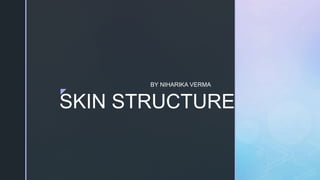
skinstructure-220321094850.pptx
- 1. z SKIN STRUCTURE BY NIHARIKA VERMA
- 2. z SKIN The technical name of skin is called ‘Derma’. Has 16% of body weight. Skin is largest evergreen changing organ. It is made up of smallest unit of life known as cell. 2 types of keratin – SOFT – Skin (Less Sulphur) - HARD – Hair and Nail (More Sulphur) _____________________________________________________________________ WHY IT IS CALLED ORGAN? - Because it functions. _____________________________________________________________________ Thinnest on eyelids. Thickest on palm and sole.
- 4. z LAYERS OF SKIN Skin is made up of 3 layers _________________________________________________________ 1. EPIDERMIS – Outer layer, scarf layer. Sub layers of epidermis i) Stratum Corneum ii) Stratum Lucidium iii) Stratum Granulosum iv) Stratum Spinosum v) Stratum Germinativum (Basale)
- 6. z STRATUM GERMINATIVUM - Cells germinates here. - Cell divide – mitosis division ( it is called Mitosis). - A single row of cells. - Nourishment provided by Dermal Papilla. - A single cell take 28 days to travel from Germinativum to Corneum (this process is called cell turn over state).
- 7. z SPECIAL CELL IN BASAL LAYER CYTE – Cell 1. Keratinocyte- Square in shape. Responsible of making keratin in our body. (a type of protein). Help in formation of skin, hair and nails. 2 . Merkel Cell- Cube in shape. Act as a sensory receptor/touch receptors. Gives sensation. 3. Langerhans Cell- Irregular shape. Gives immunity by killing pathogens- bacteria, viruses, foreign body particles.
- 8. z 4. Melanocyte- Octopus in shape. Every 10th cell is melanocyte. To produce melanin. (Color Pigment), helps to give color to skin, eyes, hair. MELANIN EUMELANIN PHEUMELANIN OXYGEN LESS OXYGEN MORE CARBON MORE CARBON LESS DARK PIGMENT LIGHT PIGMENT BLUE TO BROWN YELLOW TO PINK
- 11. z KERATINIZATION PROCESS In cells there are no nuclei, the cytoplasm contains, keratin, which is gel like structure has been replaced with soft keratin. It is also referred to as the Horney layer, because of the scale like made primarily of soft keratin called KERANITOCYE.
- 13. z MELANIZATION PROCESS MELANOCYTES contain an enzyme tyrosinase, which I responsible for forming the pigment from the amino acid tyrosinase. Ensure to UV LIGHT stimulates the activity of enzyme, and distributed to cells. It has a protective role in the skin, acting as a NATURAL SUN FILTER to reduce of deeper tissues to the harmful UV rays.
- 15. z STRATUM SPINOSUM Deepest layer. Layer interlocks the skin. Spiny Layer of particle. STRATUM GRANULOSUM Layer become granules. It is starts the process of keratinization (water). 80% of dead cells. Partially it is Keratinized Layer.
- 16. z STRATUM LUCIDIUM Clear/Transparent (Palm & Soul). No hair follicle. Eleidin Protein (Protect from UV Rays, Water Proofing). STRATUM CORNEUM All cells are dead (fully keratinized layer). Shed off in the internal of 20-28 days. Desquamation- Natural Process, dead cells removes naturally. (Manual Exfoliation – scrubbing). BASEMENT MEMBRANE – A membrane connect EPIDERMIS AND DERMIS.
- 17. z DERMIS- True skin, cutis Lye's beneath the epidermis layer. 25 times thicker than epidermis layer, Dermis layer is divided into 2 layers: 1. Papillary Layer- Upper, Connective Tissue 2. Reticular Layer- Lower, Dense Connective Tissue PAPILLARY LAYER Contains fine blood vessels, which helps to provide nutrition from reticular layer Gives nutrition to Stratum Germinativum. RETICULAR LAYER Contains all blood vessels, lymph vessels, sebaceous gland, sweat gland, arrector pilli muscle, nerve endings/receptors, hair follicle, elastin and collagen fibers.
- 19. z Blood Vessels – Helps in transportation of fresh blood and supply nutrients and oxygen. Lymph Vessels- Helps in transportation of Lymph. Hair Follicle- Tube light duct in which hair are grown. Nerve ending/receptor- Touch, pain, pressure, heat, cold Erector Pilli Muscle- An involuntary muscle, not in our control, responsible for goosebumps. Sebaceous Gland- It secrete sebum and make skin smooth and supple. Sebum is present in all over body- except palm & sole. Elastin fiber- Gives elasticity to the skin. Collagen fiber- Gives strength to the skin (produce by Fibroblast cell). Hyaluronic Acid- Natural Moisterzing Factor ( 1lt in skin).
- 20. z Sweat Glands- Technical Name is Sudoriferous Gland. Two type of Sweat Gland- 1. Apocrine Gland: Present in Armpits and Pubic Area. Active during Puberty. Milky and thick sweat. Cholesterol, fatty acids. Has bacterial growth, which cause odor. 2. Eccrine Gland: Present in all over body. Present by birth. Watery and clear sweat. Excrete water, urea, sodium chloride. No bacterial growth, no odor. Regulates body temperature.
- 21. z HYPODERMIS- Fatty layer (adipose tissue)/ Subdermis/Subcutaneous Mainly for fat storage.] Store Vitamin A, D, K, and E (water soluble). Also gives insulating effect or insulation layer. Heat resist or heat loss. Always give female characteristic curve.
- 23. z QUESTION AND ANSWER 1. Is skin is the largest organ? Yes or No 2. Most body odor is the result of bacterial metabolism of the secretions produced by _____ glands. Apocrine sweat Eccrine sweat Sebaceous 3. Contraction of the arrector pili muscles cause "goose bumps" Sweat to be released from sweat glands Hair to be shed 4. Keratin is the skin pigment that protects it against ultraviolet light. True False
- 24. z 5. The _______ contains the cells that are undergoing mitosis. Stratum granulosum Stratum spoinosum Stratum basale 6. The layer of the epidermis that contains melanocytes is the Stratum basale Stratum lucidum Stratum spinosum 7. What is the technical name of Sweat Gland Apocrine gland Eccrine Gland Sudoriferous Gland Sebaceous Gland
- 25. z 8. What is skin made up of? Melanin Keratin Epithelial tissue 9. Which cell gives color pigment? Melanin Eumelanin Phumelanin Melanocyte 10. Which area does not have sebaceous gland? Palm and sole. Pubic area Armpits
- 26. THANK YOU
